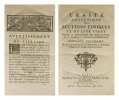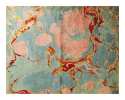4 books for « l hospital guillaume ... »Edit
-
Topics
Geometry (2)
Mathematics (1)
Tea (2)
-
Countries
Denmark (2)
France (1)
Switzerland (1)
-
Syndicate
ILAB (4)
NVVA (1)
SLACES (1)
SLAM (1)
"L'HÔPITAL (L'HOSPITAL), (GUILLAUME FRANÇOIS ANTOINE DE). - FIRST TREATISE ON THE DIFFERENTIAL CALCULUS.
Reference : 50313
(1768)
Analyse des infinite Petits. Suivie d'un nouveau Commentaire pour l'intelligence des endroits les plus difficiles de cet Ouvrage. Par l'Autheur du Guide des jeunes Mathématiciens dans l'étude des Lecons de Mathematique de M. l'Abbé de la Caille.
Avignon, Veuve Girard & Francois Seguin, 1768. 8vo. Contemp. full mottled calf. Wear to top of spine. Richly gilt spine, titlelabel with gilt lettering. (2),XXXI,380 pp. and 8 folded engraved plates. On verso of title-page a stamped exlibris. On inside frontcover an engraved exlibris ""John Cookney"". Internally clean, printed on good paper.
This edition of the first treatise on the differential calculus, first published 1696, is the first with the commentaries by the famous French astronomer Nicolas-Louis De Lacaille, taken from his noted ""Leçons élémentaires de mathématiques"".""The Analyse des infiniment petits was the first textbook of the differential calculus. The existence of several commentaries on it - one by Varignon (1725) - attests to its popularity. The question of its intellectual ownership has been much debated. Jean Bernoulli, who is known to have instructed L’Hospital in the calculus about 1691, complained after L’Hospital’s death that he (Bernoulli) had not been given enough credit for his contributions. L’Hospital himself, in the introduction to his books, freely acknowledges his indebtedness to Leibniz and to the Bernoulli brothers. On the other hand, he states that he regards the foundations provided by him as his own idea, although they also have been credited by some to Jean Bernoulli. However, these foundations can be found, less explicitly, also in Leibniz, although Leibniz made it clear that he did not accept L’Hospital’s Platonistic views on the reality of infinitely small and infinitely large quantities.""(DSB).
"L'HÔSPITAL, (GUILLAUME FRANÇOIS ANTOINE) MARQUIS DE. - CARTESIAN GEOMETRY APPLIED TO THE CONIC SECTIONS.
Reference : 48217
(1707)
Traité Analytique des Sections Coniques et de leur Usage pour la Resolution des Equations dans les Problêmes tant déterminez qu'indéterminez. Ouvrage Posthume.
Paris, Jean Boudot et Jean Boudet fils, 1707. 4to. Contemporary full calf. A bit of cracking to front hinges, so that cords are seen, but cover not loosening. Spine with 6 raised bands, richly gilt compartments. Wear to top of spine. Two small old paperlabels, one to upper compartment, one to frontcover. Covers slightly rubbed. (4),459,(5) pp. Large woodcut vignette on titlepage, 2 other vignettes, one engraved , one in woodcut. 32 folded engraved plates and one smaller folded plate (Fig. A). An old owners stamp on flyleaf. Internally clean and fine. A few tiny brownspots. Wide-margined and printed on good paper.
Scarce first edition of l'Hôspital's second book - his second successfull textbook - the manuscript of which was left completed at his death in 1704. His first book ""Analyse des infiniment petits pour l’intelligence des lignes courbes"", 1696 was the first textbook of the differential calculus, and his name lives on in the name of the rule for finding the limiting value of a fraction whose numerator and denominator tend to zero. His mathyematical teacher was Jean Bernoulli.The year in which Newton published the anti-Cartesian ""Arithmeticus"" there appeared in France a conspicuously successfull textbook on Cartesian geometry along the lines of that of Guisnée. This was the ""Traité Analytique des Sections Coniques"".... a book which contains less original material than that of Guisnée, but which is more extensive and closer to the modern manner of treatment. The work had been intended for publication at the time the authors famous calculus textbook appeared in 1696, but l'Hospital's illness apparently led to delay and it appeared posthumously in 1707. It is Cartesian in emphasis and although it consists of but one volume, follows generally the tripartite plan of Lahire and Ozanam: first an algebraic quasi-analytic treatment of the Conic Sections along the lines of Apollonian theory"" then an analytic study of the loci, and finally a long section on the customary construction by conics of the roots of cubic and quartic polynominal equations... LHospital sometimes used two axes and seems to have recognized the interchangeability of these, but he betrays some hesitation... In general, L'Hospital (like Descartes) was more interested in analytic geometry as a measure of ecpressing loci algebraivcally than as a method of deriving the properties of a curve from its equation."" (Carl B. Boyer ""History of Analytic geometry"", pp. 150-154.
Traité analytique des sections coniques et de leur usage pour la résolution des équations dans les Problêmes tant déterminés qu'indéterminés. Ouvrage posthume.
Paris, Moutard, 1776. 1 vol. in-4°, basane fauve marbrée, dos à nerfs orné de fleurons dorés, pièce de titre en basane brique, double filet doré sur les coupes, tranches rouges. Reliure de l'époque, coiffes absentes, coins émoussés, qq. épidermures. 34 planches hors-texte dont 33 numérotées repliées, (2) ff., 459 pp.,; (4) pp., (1) p. blanche.
Seconde édition de cet ouvrage, "l'un des meilleurs sur cette partie de l'analyse" (Montucla). Il avait été imprimé pour la première fois en 1707 et remis en vente en 1720. Cette édition a été soigneusement établie sur le texte de l'édition de 1707. DSB VIII, 305; Quérard V, 295.


Phone number : 02 47 97 01 40
L'HOSPITAL, Le Marquis de (Guillaume-François-Antoine ,1661-1704):
Reference : 98454aaf
Traité analytique des sections coniques et de leur usage pour la résolution des équations dans les problèmes tant déterminez qu'indéterminez. Ouvrage Postume.
A Paris, Chez Fraçois Montalant, 1720, in-4°, 4 feuilles (titre - avertissement - table - privilège du Roy) + 459 p. avec un bandeau et une lettrine gravés sur cuivre + 33 planches dépl. avec 293 figures + plus une planche non chiffrée portant une figure notée A. (page 413), reliure en plein veau d’époque, dos à cinq nerfs richement orné en or, pièce de titre. tranches rouges, un coin légèrement touché, gardes en papier dominoté originales (caillouté veiné bleu clair rose rouge), bel exemplaire en parfait état.
Deuxième édition posthume. Le géomètre français, G.-F. Antoine DE L'HOSPITAL, marquis de SAINTE-MESME et comte D'ENTREMONT fut initié à l'étude du calcul infinitésimal par Jean Bernoulli en 1692. S'il est moins important que son Analyse des infiniment petits, le Traité des sections coniques dont la première édition, posthume, est de 1707, fut pendant longtemps l'une des meilleures études sur cette partie de l'analyse et contribua aussi à placer le nom de son auteur à côté de ceux des géomètres les plus célèbres de son époque Leibniz, Huygens et les frères Bernoulli. Contemporary full calf binding, complete with 33 plates + 1 numbered A. Fine copy. Poggendorf I, 1146; Cantor III, 427; DSB VIII, 304. - cf. Pierre HUMBERT, Les Mathématiques de la Renaissance à la fin du XVIIIe siècle. DAUMAS, Histoire de la Science, 589. Image disp.

(SLACES, NVVA)
Phone number : 41 (0)26 3223808
 Write to the booksellers
Write to the booksellers









